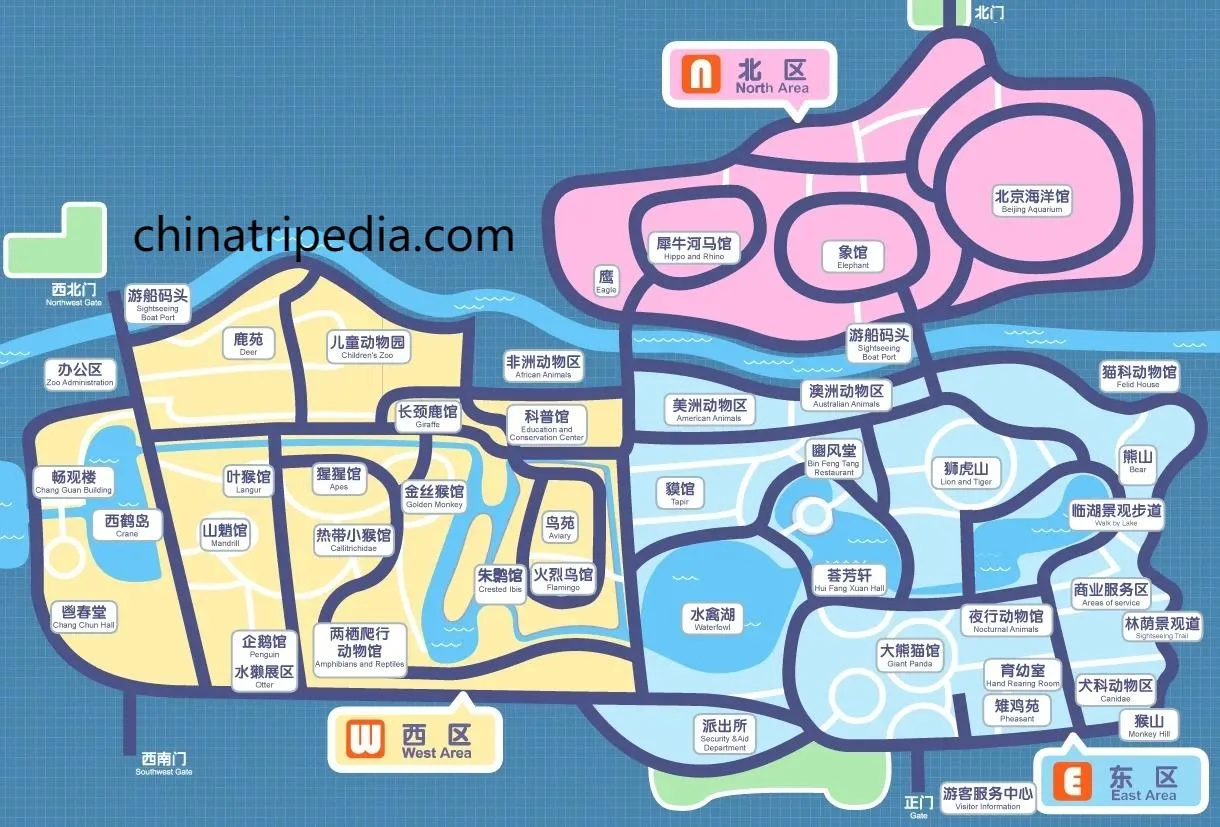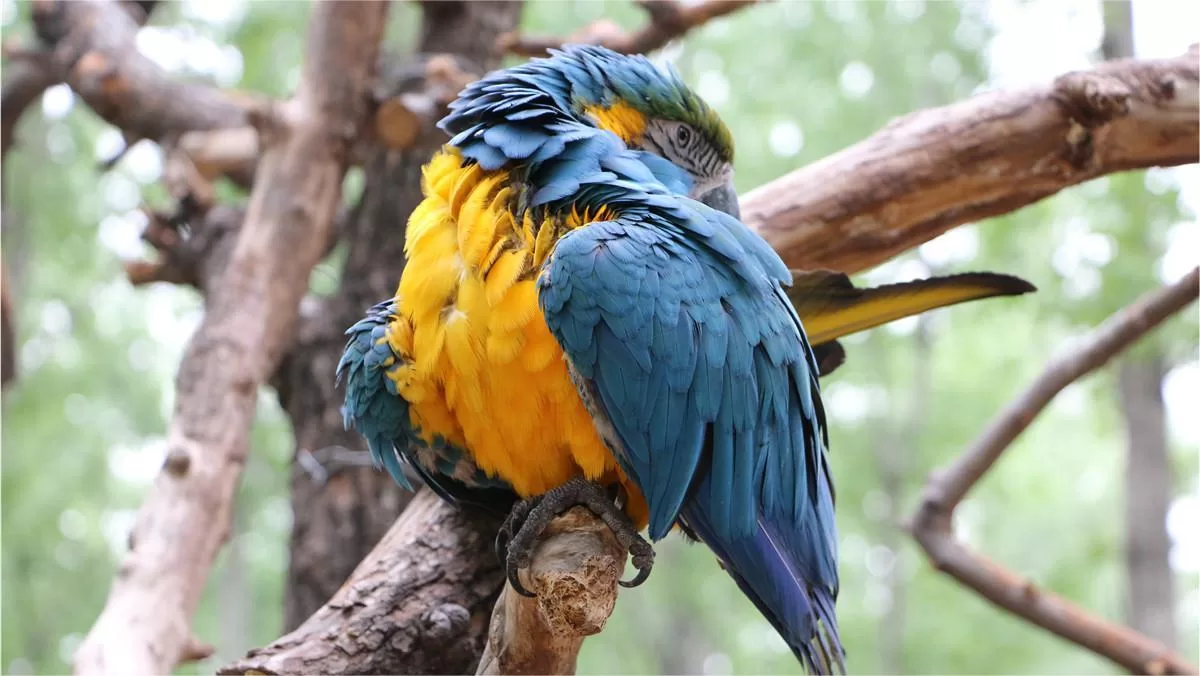Beijing Zoo (北京动物园) is a large and well-known zoo located in the Xicheng District of Beijing, China. It was established in 1906 during the Qing dynasty and has since become a popular destination for tourists and locals alike.
The zoo covers an area of over 220 acres and is home to over 14,500 animals of more than 950 different species from all around the world. Some of the most popular animals at the zoo include giant pandas, Siberian tigers, African lions, and golden monkeys. In addition to the animal exhibits, Beijing Zoo also features several gardens, including a lotus garden, peony garden, and cherry blossom garden, that offer a peaceful and scenic environment for visitors to relax in.
Table of Contents
- Basic Information
- Location and Transportation
- Highlights of Beijing Zoo
- Map and Recommended Routes
- Vlog about Beijing Zoo
- A Brief History of Beijing Zoo
- Popular Restaurants in and near Beijing Zoo
- Useful Tips Summarized from Reviews
- Explore Beijing Like A Local
Basic Information
| Website | http://www.bjzoo.com/ |
| Estimated Length of Tour | Over 3 hours |
| Ticket Price | Admission ticket: 15 RMB (1st April – 31st October) 10 RMB (1st Novermber – 31st March the next year) Giant Panda House: 5 RMB Penguin House: 10 RMB Children’s Zoo: 10 RMB Aquarium: 130 RMB |
| Opening Hours | 7.30 – 19.00; Last admission: 18.00 (1st April – 31st October) 7.30 – 17.00; Last admission: 16.30 (1st Novermber – 31st March the next year) |
| Telephone Number | 0086-010-68380274 0086-010-68314411 |
Location and Transportation
Beijing Zoo is located in the Xicheng District of Beijing, China, at No. 137 Xizhimen Outer Street. It is situated near several major landmarks, including the Beijing Aquarium, the Capital Indoor Stadium, and the National Library of China.
There are also several shopping centers, restaurants, and hotels located near Beijing Zoo, providing visitors with plenty of options for dining, shopping, and lodging.
Bus: Take bus 27, 87, 105, 107, 111, 129, 305, 332, 347, 360, 362, 534, 563, 604, or 632, get off at Beijing Zoo Stop (Beijing Dongwuyuan 北京动物园), and walk about 100 meters to the east to reach the entrance.
Subway: Take subway line 4, get off at Beijing Zoo Station, get out of the station from Exit B, and you will be standing right in front of the ticket office.
Highlights of Beijing Zoo
Giant Panda

The giant panda exhibit is one of the highlights of Beijing Zoo, and is a must-see for visitors to the park. Here, visitors can observe these beloved animals in a habitat that simulates their natural environment. The giant pandas spend much of their time eating bamboo, and visitors can watch as they munch on their favorite food. They also enjoy playing and lounging around, and visitors can witness their playful antics as they interact with each other and their surroundings.
African Savannah

The African Savannah exhibit at Beijing Zoo is a fascinating attraction that offers visitors a glimpse of some of Africa’s most majestic animals in a habitat that closely mimics their natural environment. Here, visitors can observe lions, zebras, giraffes, and elephants as they roam freely in a large, open area that replicates the sweeping grasslands of the savannah. The lions may be seen napping in the shade or prowling around, while the giraffes reach for leaves from the trees and the elephants trumpet and splash around in the water.
Aquarium

Located within the zoo, the Aquarium boasts a vast collection of over 450 different species of aquatic animals, including sharks, dolphins, sea turtles, and various types of fish. Visitors can explore a variety of exhibits that showcase the diversity of marine life from around the world, from coral reefs to deep-sea creatures. The aquarium also features an underwater tunnel that provides a unique perspective of marine life swimming above and around you.
Primate House

The Primate House at Beijing Zoo is a fascinating attraction that showcases a wide range of monkey and ape species from around the world. Visitors can observe these intelligent and social creatures as they swing and climb through the trees, play, and interact with each other. The Primate House features a diverse collection of species, including orangutans, chimpanzees, and gibbons, and visitors can learn about the unique behaviors and characteristics of each through informative displays and interactive exhibits.
Birds’ Paradise

The Birds’ Paradise exhibit at Beijing Zoo is a captivating attraction that features a diverse collection of bird species from around the world. Visitors can observe these beautiful creatures as they fly and interact with each other in a large, open-air habitat. The exhibit showcases a wide range of bird species, including eagles, parrots, and flamingos, and offers visitors a unique opportunity to appreciate their unique beauty and behaviors. Informative displays and interactive exhibits provide visitors with insights into the different types of birds and their habits.
Children’s Zoo

The Children’s Zoo at Beijing Zoo is a fun and interactive attraction that offers younger visitors a chance to learn about and interact with a variety of animals in a safe and controlled environment. The zoo features a range of domestic animals, including goats, rabbits, and guinea pigs, as well as some exotic animals, such as alpacas and wallabies. Children can learn about animal behavior and care through informative displays and interactive exhibits, and even have the opportunity to pet and feed some of the animals under the supervision of trained zookeepers. With its fun and educational exhibits, the Children’s Zoo is a great place for families with young children to spend an enjoyable and educational day at the zoo.
Map and Recommended Routes

Route 1: Enter from the South Gate (南门)
South Gate (南门) ➡ Panda House (熊猫馆) ➡ Australian Animals Area (澳洲动物区) ➡ Monkey Hill (猴山) ➡ Bear Hill (熊山) ➡ Lion and Tiger Mountain (狮虎山) ➡ Elephant House (象馆) ➡ Rhinoceros and Hippopotamus House (犀牛河马馆) ➡ Giraffe House (长颈鹿馆) ➡ African Animals Area (非洲动物区) ➡ Waterfowl Lake (水禽湖) ➡ Amphibian and Reptile House (两栖爬行馆)
Route 2: Enter from the North Gate (北门)
North Gate (北门) ➡ Bear Hill (熊山) ➡ Polar Bear House (白熊馆) ➡ Monkey Hill (猴山) ➡ Lion and Tiger Mountain (狮虎山) ➡ Panda House (熊猫馆) ➡ Giraffe House (长颈鹿馆) ➡ Elephant House (象馆) ➡ Hippopotamus House (河马馆) ➡ Penguin House (企鹅馆) ➡ Waterfowl Lake (水禽湖) ➡ Amphibian and Reptile House (两栖爬行动物馆) ➡ Orangutan House (猩猩馆) ➡ Golden Monkey House (金丝猴馆) ➡ Deer Park (鹿苑) ➡ Children’s Zoo (儿童动物园) ➡ Exit from the South Gate (南门)
Vlog about Beijing Zoo
A Brief History of Beijing Zoo
The history of Beijing Zoo dates back to the Qing dynasty in 1906, when a group of officials created a royal menagerie in the gardens of the Summer Palace. The menagerie was established to house exotic animals from all over the world that had been gifted to the emperor as diplomatic gifts.
After the fall of the Qing dynasty and the establishment of the Republic of China in 1911, the menagerie was renamed as the “Beijing Zoo” and opened to the public. In its early years, the zoo had a limited collection of animals, mostly consisting of native species and a few foreign animals.
During the Japanese occupation of China in World War II, the zoo was heavily damaged and many of its animals were killed or taken away. After the war, the Chinese government began to restore and expand the zoo, adding new exhibits and acquiring new animals.
In the 1950s and 1960s, the zoo underwent major renovations and expansions, including the construction of several new animal enclosures and gardens. It also became a research center for animal behavior and conservation, working closely with international organizations to promote animal welfare and conservation efforts.
In the 1980s and 1990s, Beijing Zoo continued to expand its collection of animals and improve its facilities. It also became a popular destination for tourists and locals alike, attracting millions of visitors each year.
Popular Restaurants in and near Beijing Zoo
1. Bamboo Forest Town (竹林小镇)
Location: Inside Beijing Zoo
Bamboo Forest Town offers a variety of small bowl meals, featuring pre-cooked meat dishes and freshly stir-fried vegetables. They also have a selection of freshly made noodle dishes, including different types of dali mian (noodles with sauce). It’s a kid-friendly place with reasonable prices, averaging around ¥30-40 per person. It’s a good spot for lunch after exploring the zoo, especially if you enter from the main gate and visit Panda House, Monkey Hill, and Bear Hill before reaching Lion and Tiger Mountain.
2. Uncle Changyu’s Noodle House (长鱼大叔浇头面)
Location: Southwest Gate of Beijing Zoo (动物园西南门外)
Uncle Changyu’s Noodle House is conveniently located just outside the southwest gate of the zoo. It’s a great place for dinner after a day at the zoo. Recommended dishes include the Soft-Shelled Longfish Noodles (软兜长鱼面), Pig Liver Noodles (猪肝面), and Kidney Noodles (腰花面). All ingredients are cleaned thoroughly and cooked over a high heat in a large iron pot to achieve a rich flavor. Don’t miss their homemade Sweet and Sour Hawthorn Dessert (酸甜山楂), a perfect treat for dessert!
Useful Tips Summarized from Reviews
Panda Exhibition: Beijing Zoo currently exhibits 9 pandas in total.
- In the Asia Games Pavilion, there are 5 pandas: Meng Da, Bai Tian, Meng Er, Meng Meng, and Fu Xing.
- Among them, Meng Da and Bai Tian share both indoor and outdoor areas; Meng Er and Meng Meng share both indoor and outdoor areas; Fu Xing has both indoor and outdoor areas.
- In the Olympic Pavilion, there are 4 pandas: Meng Lan, Meng Bao, Meng Yu, and Dian Dian.
- Meng Lan only has an outdoor area, no indoor area; Meng Bao and Meng Yu are together and only have an indoor area, no outdoor area; Dian Dian also only has an indoor area.
- Two pandas, Ya Ya and Gu Gu, are currently retired and not available for public display.
Best Time to Visit Pandas: Pandas prefer cooler temperatures and are less active during hot weather. It’s recommended to visit them when the weather is cooler or during snowfall. Early mornings around 8 or 9 AM are generally when pandas are most active.
Facilities and Transportation: You can rent strollers at the main entrance, which is advisable if you have young children, as the zoo is quite large. There are shuttle buses available within the zoo for 10 yuan per ride.
Rules and Regulations: Feeding animals is strictly prohibited in the zoo, and violators may face a fine of 50 yuan.
Avoiding Crowds: During summer vacations, the zoo can get crowded, and there might be queues at the entrance. To avoid this, you can take subway lines 4, 9, or 16 to the National Library station and exit from Exit C. From there, walk a short distance forward until you reach the South Changhe Road. Walk along the riverbank to the east for about 800 meters (you’ll pass by the Capital Indoor Stadium). On your right, you’ll see a small bridge. Cross the bridge, and you’ll arrive at the northwest gate of the zoo, where there are usually fewer visitors.



People who are planning to visit the zoo should plan for a whole day. Once you have your ticket, you can go anytime; the time slots are just for crowd control for a better experience. Buying a 19 ticket allows you to see the giant pandas directly without the need to purchase an additional ticket for the panda pavilion. Try to go early in the morning when the animals are more active. If you go later, you’ll only see them… Read more »